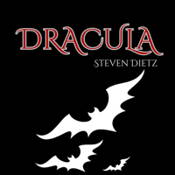
Overview
Synopsis
Bram Stoker’s 1897 novel Dracula popularized the Gothic genre and brought vampire fiction to a mass audience, shaping popular understanding of the mythological creature. While playwright Steven Dietz takes some theatrical liberties, this adaptation is largely faithful to the source material and preserves the major plot and characters. Also intact are the style and tone of the original novel, complete with gore, special effects, and melodrama. The play is anchored with a prologue and epilogue delivered by Renfield, a mysterious, insane asylum patient under the spell of Count Dracula, a vampire who is equal parts debonair and violent. When the young Lucy begins to transform into a vampire, her best friend Mina summons the psychiatrist Dr. Seward to examine her. Flummoxed, Seward calls in his mentor, Professor Van Helsing. When Dracula’s lawyer and Mina’s fiancé Harker returns from Dracula’s castle in a state of shock, his journal paints a picture of the full extent of Dracula’s power. As the stakes get higher, the group must fight time to defeat evil. With an ensemble cast and minimal scenic requirements, Dietz’s adaptation offers a gripping horror play for theatres of any size or technical capability.
Show Information
Context
Dracula is an adaptation of Bram Stoker’s 1897 novel of the same name. Through newspaper articles, letters, and diaries, the novel tells the story of Count Dracula, a vampire who leaves his castle and takes a ship to England. There, he stalks 19-year-old Lucy, best friend of Mina. Mina’s fiancé, Jonathan Harker, is a solicitor (lawyer) who helped Dracula buy a house in England. After Lucy falls ill and dies mysteriously, reports begin to circulate of children being stalked at night by a
to read the context for Dracula and to unlock other amazing theatre resources!Plot
Act One
A man named Renfield sits at a dining table sipping red wine. He describes Bram Stoker and tells the audience that Stoker made him and gave him immortality. Renfield removes the cover on a platter to reveal a live rat, which he lowers into his mouth as attendants run on and haul him away.
Best friends Mina and Lucy sit in Lucy’s room. Mina describes her passion for her fiancé, lawyer Jonathan Harker. Lights come up on Harker as he writes a letter describing his trip to
to read the plot for Dracula and to unlock other amazing theatre resources!Characters
| Name | Part Size | Gender | Vocal Part |
|---|---|---|---|
|
Lead |
Male |
Non-singer |
|
|
Lead |
Male |
Non-singer |
|
|
Lead |
Female |
Non-singer |
|
|
Lead |
Female |
Non-singer |
|
|
Supporting |
Male |
Non-singer |
|
|
Supporting |
Male |
Non-singer |
|
|
Supporting |
Male |
Non-singer |
|
|
Featured |
Male |
Non-singer |
|
|
Featured |
Female |
Non-singer |
|
|
Featured |
Female |
Non-singer |
Songs
A song with an asterisk (*) before the title indicates a dance number; a character listed in a song with an asterisk (*) by the character's name indicates that the character exclusively serves as a dancer in this song, which is sung by other characters.
Monologues
Scenes
Key Terms
An adaptation is a reworking of a story from one medium or cultural context into another, such as turning a novel into a play or updating a classic play’s setting. Adaptations often reinterpret themes, characters, and style for new audiences. They can range from faithful recreations to bold reimaginings.
A performance technique where an actor speaks directly to the audience, breaking the fourth wall for dramatic or comedic effect.
A literary and dramatic style emphasizing horror, emotion, and the supernatural. This term plays a vital role in understanding theatrical structure and is commonly encountered in stagecraft or performance settings.
A plot structure that presents events out of sequence to challenge perception, deepen theme, or reflect fragmented experience.
Videos
Quizzes
Themes, Symbols & Motifs
Sorry! We do not currently have learning modules for this guide.
Quote Analysis
Sorry! We do not currently have learning modules for this guide.
